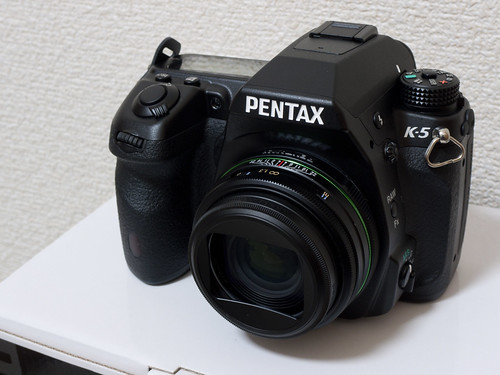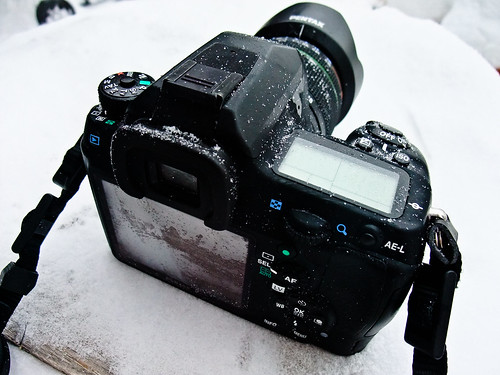Difference between revisions of "Pentax K-5"
m |
m ("to") |
||
| Line 10: | Line 10: | ||
While the [[Pentax K-7|K-7]] DLSR from [[Pentax]] had been generally praised as offering good build quality and ergonomics in a compact package, its 14 megapixel [[sensor]] from [[Samsung]] had been criticized as not quite competitive with its peers (or even with Pentax's own much cheaper [[Pentax K-x|K-x]]). Accordingly, the K-7's 2010 replacement, the '''Pentax K-5''', switched to a new 16 Mp sensor from [[Sony]]. This chip made quite a splash with technically-minded review sites, taking the top spots in performance among its APS-C sensor contemporaries<REF>[http://www.dxomark.com/index.php/Publications/DxOMark-Reviews/DxOMark-review-for-the-Pentax-K5 Pentax K-5 analyzed] by [http://www.dxomark.com/ DxO Labs].</REF>. (A nearly-identical chip is apparently used in the [[Nikon D5100]] and [[Sony Alpha DSLR-A580|Sony A580]]<REF>[http://www.dxomark.com/index.php/en/Cameras/Compare-Camera-Sensors/Compare-sensors/%28appareil1%29/676|0/%28appareil2%29/698|0/%28appareil3%29/685|0/%28onglet%29/0/%28brand%29/Pentax/%28brand2%29/Nikon/%28brand3%29/Sony Pentax K-5, Nikon D5100, and Sony Alpha A580 sensor raw comparison] from [http://www.dxomark.com/ DxO Mark].</REF>.) | While the [[Pentax K-7|K-7]] DLSR from [[Pentax]] had been generally praised as offering good build quality and ergonomics in a compact package, its 14 megapixel [[sensor]] from [[Samsung]] had been criticized as not quite competitive with its peers (or even with Pentax's own much cheaper [[Pentax K-x|K-x]]). Accordingly, the K-7's 2010 replacement, the '''Pentax K-5''', switched to a new 16 Mp sensor from [[Sony]]. This chip made quite a splash with technically-minded review sites, taking the top spots in performance among its APS-C sensor contemporaries<REF>[http://www.dxomark.com/index.php/Publications/DxOMark-Reviews/DxOMark-review-for-the-Pentax-K5 Pentax K-5 analyzed] by [http://www.dxomark.com/ DxO Labs].</REF>. (A nearly-identical chip is apparently used in the [[Nikon D5100]] and [[Sony Alpha DSLR-A580|Sony A580]]<REF>[http://www.dxomark.com/index.php/en/Cameras/Compare-Camera-Sensors/Compare-sensors/%28appareil1%29/676|0/%28appareil2%29/698|0/%28appareil3%29/685|0/%28onglet%29/0/%28brand%29/Pentax/%28brand2%29/Nikon/%28brand3%29/Sony Pentax K-5, Nikon D5100, and Sony Alpha A580 sensor raw comparison] from [http://www.dxomark.com/ DxO Mark].</REF>.) | ||
| − | The K-5 otherwise kept most of the same feature set as the K-7, including a weather-sealed magnesium-alloy body, sensor-shift shake reduction, and full support for legacy [[K-mount lens]]es (the body is able to set the aperture of Pentax manual-focus lenses dating back to the 1983 Pentax-A series). The K-5 did add an update the autofocus system, and video recording was increased to 1080p "full HD." | + | The K-5 otherwise kept most of the same feature set as the K-7, including a weather-sealed magnesium-alloy body, sensor-shift shake reduction, and full support for legacy [[K-mount lens]]es (the body is able to set the aperture of Pentax manual-focus lenses dating back to the 1983 Pentax-A series). The K-5 did add an update to the autofocus system, and video recording was increased to 1080p "full HD." |
==Notes== | ==Notes== | ||
Revision as of 17:22, 9 July 2011

|
| K-5 with DA Limited 21mm f/3.2 wideangle image by nubobo (Image rights) |
While the K-7 DLSR from Pentax had been generally praised as offering good build quality and ergonomics in a compact package, its 14 megapixel sensor from Samsung had been criticized as not quite competitive with its peers (or even with Pentax's own much cheaper K-x). Accordingly, the K-7's 2010 replacement, the Pentax K-5, switched to a new 16 Mp sensor from Sony. This chip made quite a splash with technically-minded review sites, taking the top spots in performance among its APS-C sensor contemporaries[1]. (A nearly-identical chip is apparently used in the Nikon D5100 and Sony A580[2].)
The K-5 otherwise kept most of the same feature set as the K-7, including a weather-sealed magnesium-alloy body, sensor-shift shake reduction, and full support for legacy K-mount lenses (the body is able to set the aperture of Pentax manual-focus lenses dating back to the 1983 Pentax-A series). The K-5 did add an update to the autofocus system, and video recording was increased to 1080p "full HD."
Notes
Links

|
| Frosty K-5 demonstrates its environmental seals image by Kurt Bauschardt (Image rights) |